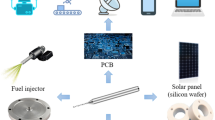Abstract
Conical point drills are often used for making holes. In drill design, three drill point parameters, namely, drill point angle (or semi-point angle), chisel edge angle, and lip clearance angle, are specified. Geometrically, the conical point geometry is generated by two symmetric and oblique cones intersecting at the end of drill land. Thus, the drill point has to be designed in detail, which is to calculate the cone location and orientation parameters so that the drill point parameter values are equal to the specifications. Unfortunately, the previously proposed methods of drill point detailed design cannot be implemented in cutting tools companies, because one set of drill point parameter specifications can correspond to many sets of cone parameters which determine different drill point shapes. Moreover, the heel clearance flanks of some drills could rub stock material at the hole bottom while drilling, resulting in a large amount of force and heat, tool breakage, and severe wear. Drills with flank rubbing are invalid. However, the previous researches and applied industrial software cannot eliminate flank rubbing. To address the above problems, a practical and explicit mathematical model of conical drill point geometry without flank rubbing is established in this work. This work derives close-formed equations of the cone parameters and establishes a new criterion of flank rubbing detection. It can efficiently and consistently compute the cone parameters and detect flank rubbing for a valid drill point design. This explicit mathematical model is verified, and an approach to conical point detailed design is applied on two twist drills in the authors’ company. The differences between the drill point parameter values in the ground drill and the drill design parameter specifications are within an acceptable tolerance. Thus, the proposed method can be directly used in drill design and manufacturing in the tooling industry.















Similar content being viewed by others
References
Ren K, Ni J (1999) Analyses of drill flute and cutting angles. Int J Adv Manuf Technol 15(8):546–553
Lin C, Kang SK, Ehmann KF (1995) Helical micro-drill point design and grinding. J Eng Ind 117(3):277–287
Tsai WD, Wu SM (1979) A mathematical model for drill point design and grinding. J Eng Ind 101(3):333–340
Sambhav K, Tandon P, Dhande SG (2012) Geometric modeling and validation of twist drills with a generic point profile. Appl Math Model 36(6):2384–2403
Hsieh JF, Lin PD (2002) Mathematical model of multi-flute drill point. Int J Mach Tool Manu 42(10):1181–1193
Hsieh JF (2009) Mathematical modeling of a complex helical drill point. J Manuf Sci Eng 131(6):061006
Du C, Chen ZC, Wang L (2014) A study on modeling and grinding for twist drill flank. Proceedings of the 2014 International Conference on Innovative Design and Manufacturing, July 2014, Montreal, Canada
Zeng T, Tang AM (2011) An approximate solution to grinding parameters of conical flank of a new type of twist drill. J Manuf Technol Mach Tools (in Chinese) 9:124–126
Tang F, Bai J, Wang X (2014) Practical and reliable carbide drill grinding methods based on a five-axis CNC grinder. Int J Adv Manuf Technol 73(5–8):659–667
Zhang W, He FB, Xiong DL (2005) Parameterized geometric design for complex helical drill point. J Manuf Sci Eng 127:319–327
Yan L, Jiang F (2013) A practical optimization design of helical geometry drill point and its grinding process. Int J Adv Manuf Technol 64(9–12):1387–1394
Wang J, Zhang Q (2008) A study of high-performance plane rake faced twist drills. Part I: geometrical analysis and experimental investigation. Int J Mach Tools Manuf 48:1276–1285
Zhang Q, Wang J (2010) Geometry, specification, and drilling performance of a plane rake faced drill point design. Proc Inst Mech Eng C J Mech Eng Sci 224(2):369–378
Xiong L, Fang N, Shi H (2009) A new methodology for designing a curve-edged twist drill with an arbitrarily given distribution of the cutting angles along the tool cutting edge. Int J Mach Tools Manuf 49(7–8):667–677
Paul A, Kapoor SG, DeVor RE (2005) Chisel edge and cutting lip shape optimization for improved twist drill point design. Int J Mach Tools Manuf 45(4–5):421–431
Selvam SM, Sujatha C (1995) Twist drill deformation and optimum drill geometry. Comput Struct 57(5):903–914
Wojciechowski S, Chwalczuk T, Twardowski P, Krolczyk GM (2015) Modeling of cutter displacements during ball end milling of inclined surfaces. Arch Civ Mech Eng 15(4):798–805
Zhang S, Liang Z, Wang X, Zhou T, Jiao L, Yan P, Jian H (2016) Grinding process of helical micro-drill using a six-axis CNC grinding machine and its fundamental drilling performance. Int J Adv Manuf Technol 86(9–12):2823–2835
Guo H, Wang X, Liang Z, Zhou T, Jiao L, Liu Z, Teng L, Shen W (2018) Drilling performance of non-coaxial helical flank micro-drill with cross-shaped chisel edge. Int J Adv Manuf Technol 99(5–8):1301–1311
Guo H, Liang Z, Wang X, Zhou T, Jiao L, Teng L, Shen W (2018) Influence of chisel edge thinning on helical point micro-drilling performance. Int J Adv Manuf Technol 99(9–12):2863–2875
Chen WC, Fuh KH, Wu CF, Chang BR (1996) Design optimization of a split-point drill by force analysis. J Mater Process Technol 58(2–3):314–322
Chandrasekharan V, Kapoor SG, DeVor RE (1998) A mechanistic model to predict the cutting force system for arbitrary drill point geometry. J Manuf Sci Eng 120(3):563–570
Abele E, Fujara M (2010) Simulation-based twist drill design and geometry optimization. CIRP Ann 59(1):145–150
Funding
The support from the National Science and Engineering Research Council of Canada and the Zhuzhou Cemented Carbide Cutting Tools Co., Ltd., China is highly appreciated. And this research was funded by the National Major Science and Technology Project of China for advanced CNC machine tools and basic manufacturing equipment (Grant No. 2018ZX04041001).
Author information
Authors and Affiliations
Corresponding author
Additional information
Publisher’s note
Springer Nature remains neutral with regard to jurisdictional claims in published maps and institutional affiliations.
Rights and permissions
About this article
Cite this article
Zeng, T., Chen, Z.C., Liu, Z. et al. An applied explicit mathematical model of conical drill point geometry without flank rubbing. Int J Adv Manuf Technol 106, 3707–3720 (2020). https://doi.org/10.1007/s00170-019-04759-y
Received:
Accepted:
Published:
Issue Date:
DOI: https://doi.org/10.1007/s00170-019-04759-y



